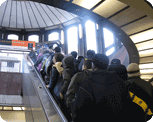
(3/9/09)
Despite falling gas prices and a recession, increasing numbers of Americans took 10.7 billion trips on public transportation in 2008, the highest level of ridership in 52 years and a modern ridership record, according to a report released today by the American Public Transportation Association (APTA). This represents a 4.0 percent increase over the number of trips taken in 2007 on public transportation, while at the same time, vehicle miles traveled (VMTs) on our nation’s roads declined by 3.6 percent in 2008, according to the U.S. Department of Transportation.
“Even as gas prices fell for the second half of the year and hundreds of thousands of people lost jobs, more and more people chose to ride public transportation throughout the country,” said APTA president William W. Millar. “Given our current economic condition, people are looking for ways to save money and taking public transportation offers a substantial savings of more than $8,000 a year. That’s quite a savings.”
Millar also announced the launch of a new advocacy campaign, Public Transportation Takes Us There, which is aimed at building congressional support for the authorization of the federal surface transportation legislation, which expires Sept. 30, 2009.
Beyond the need for greater public transit investment in a new federal surface transportation bill (the current one legislation expires September 30, 2009), and the 2010 appropriations bill, APTA is advocating for the inclusion of public transportation investment in any energy or climate change bill.
“Every year, public transportation saves 4.2 billion gallons of gasoline and reduces our nation’s carbon emissions by 37 million metric tons,” said Millar. “Clearly, public transportation is part of the solution for our country’s national goals of energy independence and carbon emissions reduction.
Millar also called on local and state governments to increase their investment in public transportation. Currently, transit systems are facing fare increases, service reductions, and layoffs – at a time of record ridership – because of declining state and local revenues.
2008 Ridership Breakdown
For the second year in a row, ridership on all modes of public transportation increased in every quarter. Light rail (modern streetcars, trolleys, and heritage trolleys) had the highest percentage of annual ridership increase among all modes, with an 8.3 percent increase in 2008. The light rail system that started in November 2007 in Charlotte, NC showed the highest percentage of increase with an annual 862 percent increase. The New Orleans, LA light rail system, which is still recovering from Hurricane Katrina, had an annual increase of 218 percent. Light rail systems with double digit ridership in 2008 were located in the following areas: Buffalo (23.9%); Philadelphia (23.3 %); Sacramento (14.4%); Baltimore (13.7%); Minneapolis (12.3%); Salt Lake City (12.3%); the state of New Jersey (10.9%); Denver (10.5%); and Dallas (10.2%).
Commuter rail increased in 2008 by 4.7 percent. The commuter rail systems with the double digit ridership growth rate in 2008 were located in the following areas: Albuquerque (35.1%); Portland, ME (26.5%); Seattle (23.8%); Pompano Beach, FL (22.9%); Harrisburg-Philadelphia (17.7%); New Haven (17.5%); Oakland (16.1%); Stockton, CA (14.7%); Dallas-Fort Worth (14.1%); San Carlos, CA (12.5%).
Heavy rail (subways) ridership increased by 3.5% in 2008. The heavy rail systems with the highest increases in ridership for 2008 were in the following cities: San Juan (13.3%); Lindenwold, NJ (9.9%); Atlanta (8.6%); Miami (8.2%), Boston (7.9%), and Los Angeles (7.7%).
Bus service saw an increase of 3.9 percent, but in communities with a population of less than 100,000, bus services saw an increase of 9.3 percent in 2008. Major increases by large bus agencies occurred in the following cities: Phoenix (11.5%); San Antonio (10.2%); San Diego (10.0%); St. Louis (8.9%); Baltimore (8.7%); and Denver (8.6%).
Demand response (paratransit) increased in 2008 by 5.9 percent.
complete APTA ridership report
public transportation’s role in climate change and energy independence
